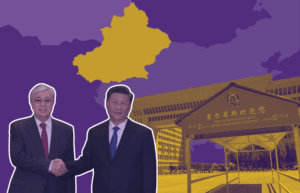Ever since February 24, 2022, coverage of the war in Ukraine has been complicated for Central Asia. Between voluntary omission by official media and pressure on those who dare call the “special operation” a war and invasion, the independent press in Central Asia is being tested by the Kremlin and its restrictive federal agency Roskomnadzor.With significant dependence on Russian network infrastructure, as well as the dominance of Russian content in information distribution, what kind of space do Central Asian media agencies have to exercise digital sovereignty? An analysis of the Central Asian media landscape under persistent Russian influence.This article was originally published on Novastan’s French website on 14 October 2022. It is a turnaround of events that speaks volumes about the freedom of speech in Kazakhstan. Beeline, the main Kazakh operator, had announced the withdrawal of certain Russian channels broadcasting on national territory, including Channel One Russia and NTV, Kremlin propaganda machines. However, the group went back on their decision on 3 October, says Kazakh media outlet Vlast, following an interview with the Russian Ministry of Digital Development. “In Astana, the interruption of Russian television channels broadcasting is keenly discussed, and the majority is in favour. But the thing is that nothing changes,” explains Kazakh political commentator Dimash Alzhanov to Novastan. Despite pressure from civil society, Kazakh television remains under Russian influence, something which is also true of written press media.
Indeed, an investigation by MediaZona revealed that Moscow blocked certain independent Central Asian media websites by means of the federal agency Roskomnadzor. The state censorship agency sent warning letters to Russian-speaking Kazakh and Kyrgyz press services, demanding that they remove various articles related to the war in Ukraine. This specifically affected Kloop in Kyrgyzstan, in addition to Katel and NewTimes in Kazakhstan.
Censorship of the war in Ukraine
According to director of Kyrgyz media outlet Kloop, quoted in the MediaZona article, Roskomnadzor blocks Internet websites employing the word “war” and not “special operation,” the official term to designate the invasion of Ukrainian by the Kremlin. Although these “warnings” only apply to media within Russian borders and do not restrict Central Asian media agencies inside their own countries, Dimash Alzhanov stresses the fact that these gestures are implemented in order to “impose certain sanctions” and to silence them. The director of the Kazakh public foundation Legal Media Center, Diana Okremova, affirmed in an interview with MediaZona that “some of Roskomnadzor’s actions can be qualified as elements of information warfare.” Blocking Central Asian websites dates to before the beginning of the war in Ukraine. According to the MediaZona article, Roskomnadzor has been expanding control over Central Asian media for several years, forcing some to erase content mentioning citizen suicides, something prohibited under Russian law. This was the case in 2017 with the Kazakh site Rika.tv, and the Tajik website Asia-Plus in 2019.
Central Asia: Russia’s “information space”
Consequently, Central Asia and its media have been commanding Russia’s attention for some time. “They have been influencing us for about ten years. Russia is trying to attract Central Asian countries into its own information space. The Russian Federation uses television channels as a means to disseminate its propaganda,” explains Dimash Alzhanov. In Kazakhstan, some Russian channels will still be broadcasted because both countries have signed an intergovernmental cooperation agreement on the airing of mass information. For Russia, “the idea is to mix information – even disinformation – and entertainment. These shows use Kazakhs in their programmes to make them ‘less Russian,’ and to ensure that society increasingly watches Moscow-made content,” analyses the political scientist.
Information consumption leans heavily towards Russian-language content
In an interview given to Vlast, political scientist Shalkar Nurseitov explains that the real issue in Central Asia is “the ease of access to Russian media. Most citizens have access to media spreading the Kremlin’s agenda, and those who lack critical thinking believe propaganda.” In 2019 and 2021, international organisation Internews led a study in Kazakhstan, Tajikistan, and Uzbekistan about media consumption patterns of the population. The results, reported by Kazakh outlet Masa Media, showed that 30% of respondents receive their news via television in Kazakhstan, while the percentage is higher in Tajikistan and Uzbekistan. In Kazakhstan, the vast majority of viewers watch television in Russian, with only 11% watching in Kazakh. Furthermore, over half the respondents read newspapers, magazines, and websites in Russian, while only a little over 8% consumed written material in Kazakh.
Pressures from within
“If the broadcasting of Russian channels is limited, it does not mean that the problem of freedom of speech will be resolved in Kazakhstan,” said Dimash Alzhanov. “The issue of information manipulation by those in power remains, and therefore freedom of speech may only be guaranteed by a balanced political system.” In April 2022, NGO Reporters Without Borders published a report exposing the pressure that online Central Asian media agencies have been subjected to by national authorities since the beginning of the conflict. Official news websites and state channels in Central Asian republics have avoided using the words “war” or “invasion” since last February, or do not even mention it, as is the case in Tajikistan. This is also what happened in Kazakhstan at the start of the invasion in Ukraine, when, according to Dimash Alzhanov, state media purposely avoided mentioning the subject. This matches the period in which President Kassym-Jomart Tokayev did not know how to position himself and whether he should support Vladimir Putin or not. RSF also points out that Central Asian countries are not well ranked in terms of freedom of the press. Uzbekistan is ranked 157th out of 180 countries on the Press Freedom Index, while Kyrgyzstan is 79th. Kazakhstan sits at 155th, while Tajikistan at 162nd, and Turkmenistan at 178th. Dependence on Russian networks The media landscape in Central Asian countries can also be explained by their structural dependency on Russia. In Kazakhstan, for instance, “at least 95% of internet traffic goes through Russia,” explains Talgat Nourlybaiev to Kazakh media site 365.kz. According to Gregory Joubert, former student at the French Geopolitical Institute and specialist on Kazakh cyberspace, it is through data that Russia exerts control in Central Asia first and foremost. This is done through “Russian Big Tech,” namely Mail.ru, Vkontakte, or Yandex. Therefore, telecommunications in Central Asia remain a major means of influence for Moscow, forming part of its information strategy. “Russia can theoretically interfere in the Central Asian informational sphere by restricting access to certain resources, given that telecommunication operators in Russia are legally bound to respond to demands.” Thus, as the former student researcher explains, “if Russia had the ambition to attack Kazakhstan for instance, internet structure would be significant.”
Written by Emma Collet for Novastan’s French website.
Translated to English by Emma Bekrine.
Edited by Mari Paine.
For more news and analysis from Central Asia, follow us on Twitter, Facebook, Telegram, Linkedin or Instagram.
 Pressure from Russia increases on Central Asian media outlets
Pressure from Russia increases on Central Asian media outlets 



